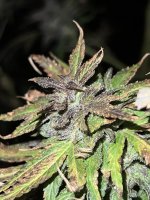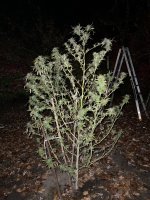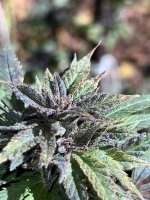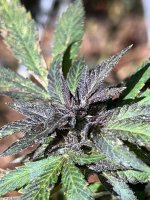TRSC Chitrali almost done. Topped out just over 6 feet. Plant was somewhat susceptible to septoria leaf spot thus the whittled appearance in the pics - but she flowered very early and kept leaves on long enough to have the energy to throw reasonably thick and very solid colas with hard clusters - much firmer than any other landrace I’ve grown.
Every single female plant this year has purple flowers, and this is no exception. Maybe half the trichomes are milky but I’d like to let her go a little longer if possible, assuming the Septoria doesn’t penetrate further into the
flowers. I have a rainy night coming up - and after an August and early September drought I did have recent two heavy rainstorms - but so far I haven’t seen any botrytis
 I will likely cut the cola ends within a few days and let the rest flesh out some more.
I will likely cut the cola ends within a few days and let the rest flesh out some more.
The smell keeps transforming, initially it was more mandarin and gasoline, it still retains some of that but has gotten a bit floral as well -





Every single female plant this year has purple flowers, and this is no exception. Maybe half the trichomes are milky but I’d like to let her go a little longer if possible, assuming the Septoria doesn’t penetrate further into the
flowers. I have a rainy night coming up - and after an August and early September drought I did have recent two heavy rainstorms - but so far I haven’t seen any botrytis
The smell keeps transforming, initially it was more mandarin and gasoline, it still retains some of that but has gotten a bit floral as well -








